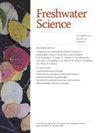淡水贻贝穴居位置及其与河床粗糙度的关系
IF 1.6
4区 环境科学与生态学
Q3 ECOLOGY
引用次数: 1
摘要
淡水贻贝部分或全部生活在河流沉积物中,贻贝的挖洞会引起生物扰动,增加底栖生物的复杂性,在其他贻贝物种之间提供生态位分配,并可能减少贻贝在高流量期间移动的机会。然而,仍然需要更好地了解影响贻贝洞穴位置的因素以及洞穴位置如何改变物理和水力栖息地。在这项研究中,我们研究了美国东北部两条砾石河床中贻贝穴居位置在不同物种之间的变化,以及穴居位置如何改变底栖生物栖息地。我们量化了底栖贻贝对河床的贡献量,并确定了洞穴位置对河床粗糙度和近河床流型的贡献。我们发现洞穴的位置因物种而异,这可能受到贝壳形态、雕塑类型和河流特征的影响。我们观察到,暴露在水柱中的贝壳数量与发现贻贝的粗粒度沉积物相似。我们还发现,贻贝壳暴露的高度大于中位粒度,因此可能影响近床流。此外,由于较大的粒度控制了沉积物的稳定性,因此与粗沉积物相似的洞贻贝暴露长度有助于增强河床的稳定性,降低沉积物的移位风险。更好地了解贻贝洞穴位置如何影响这些重要的生物物理过程,可能有助于确定重要的狭缝效应或最小生存种群指数,这可能有助于保护和恢复工作。本文章由计算机程序翻译,如有差异,请以英文原文为准。
Freshwater mussel burrow position and its relation to streambed roughness
Freshwater mussels live partially or fully buried in river sediments, and burrowing by mussels causes bioturbation, increases benthic complexity, provides niche partitioning among other mussel species, and may reduce the chance of mussel dislodgment during high flows. However, there remains a need to better understand what influences the burrow position of mussels and how burrow position modifies physical and hydraulic habitat. In this study, we examined how mussel burrow position varied across species in 2 gravel-bedded rivers in the northeastern USA and how burrow position modified benthic habitat. We quantified the amount of benthic habitat mussels contributed to the riverbed and determined the contribution of burrow position to bed roughness and near-bed flow patterns. We found that burrow position varied by species, which was likely influenced by shell morphology, sculpture type, and river characteristics. We observed that the amount of shell exposed into the water column was similar to the coarse-sized sediment where mussels were found. We also found that mussel shells were exposed at a height greater than the median grain size and could, therefore, influence near-bed flows. Moreover, because larger grain sizes control sediment stability, the similar exposed length of burrowed mussels as coarse sediment could contribute to enhanced bed stability and reduce the risk of dislodgement. Better understanding of how mussel burrow position influences these important biophysical processes may help identify important Allee effects or minimum viable population indices, which may aid conservation and restoration efforts.
求助全文
通过发布文献求助,成功后即可免费获取论文全文。
去求助
来源期刊

Freshwater Science
ECOLOGY-MARINE & FRESHWATER BIOLOGY
CiteScore
4.10
自引率
0.00%
发文量
49
审稿时长
6-12 weeks
期刊介绍:
Freshwater Science (FWS) publishes articles that advance understanding and environmental stewardship of all types of inland aquatic ecosystems (lakes, rivers, streams, reservoirs, subterranean, and estuaries) and ecosystems at the interface between aquatic and terrestrial habitats (wetlands, riparian areas, and floodplains). The journal regularly features papers on a wide range of topics, including physical, chemical, and biological properties of lentic and lotic habitats; ecosystem processes; structure and dynamics of populations, communities, and ecosystems; ecology, systematics, and genetics of freshwater organisms, from bacteria to vertebrates; linkages between freshwater and other ecosystems and between freshwater ecology and other aquatic sciences; bioassessment, conservation, and restoration; environmental management; and new or novel methods for basic or applied research.
 求助内容:
求助内容: 应助结果提醒方式:
应助结果提醒方式:


